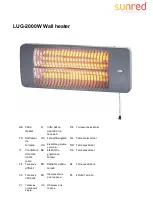
15
5.5. Vent Piping
A
A
WARNING:
Indoor heaters require a drafthood that
must be connected to a vent pipe and properly vented to
the outside. Failure to follow this procedure can cause
fire or fatal carbon monoxide poisoning.
Vent piping the same size as the drafthood outlet is
recommended, however, when the total vent height is at
least 10 ft (drafthood relief opening to vent terminal), the
vent pipe size may be reduced by no more than one (1)
size as specified in Chapter 13 of the National Fuel Gas
Code, ANSI Z223.1 (Canada - CAN/CSA-B149). As much
as possible, avoid long horizontal runs of vent pipe and too
many elbows. If installation requires horizontal runs, the
vent pipe must have a minimum of 1/4 in. per ft rise and
should be supported at not more than five foot intervals.
Plumbers tape, criss-crossed, will serve to space both
horizontal and vertical piping. Gas vents supported only
by the flashing and extending above the roof more than
five feet should be securely guyed or braced to withstand
snow and wind loads. We recommend use of insulated
vent pipe spacers through the roofs and walls. Another
option for installation that requires horizontal runs is
using the D-2 power vent kit option.
Model
120 VAC P/N
240 VAC P/N
268
010744
009832
408
010745
009833
Table G. Power Vent Kit Part Number
NOTE:
The D-2 Power Vent operates with a positve
vent static pressure and with a vent gas temperature
that prevents excessive condensate production in the
vent, and as such, is a CATEGORY III appliance. For
more information consult the D-2 Power Vent manual
6000.57.1.
Figure 11. Optional Raypak D-2 Power Vent
The unit, when installed as directed, is capable of
operating in applications such as through-the-wall venting
and reduced horizontal and vertical vent pipe sizes in new
and current installations. The unit is factory-wired for 240
VAC, with capability of rewiring for 120 VAC.
For protection against rain or blockage by snow, the vent
pipe must terminate with a vent cap which complies with
the local codes or, in the absence of such codes, to the
latest edition of the National Fuel Gas Code, ANSI Z223.1
(Canada - CAN/CSA-B149).
The discharge opening must be a minimum of 2' (0.6
M) vertically from the roof surface and at least 2' (0.6 m)
higher than any part of the building within 8' (2.4 m). Vent
stack shall be at least 5' (1.5 m) in vertical height above
the drafthood outlet. The vent cap location shall have a
minimum clearance of 4' (1.2 m) horizontally from, and in
no case below, unless a 4' (1.2 m) horizontal distance is
maintained, from electric meters, gas meters, regulators
and relief equipment.
The weight of the vent stack or chimney must not rest on
heater drafthood. Support must be provided in compliance
with applicable codes. The heater top and drafthood must
be readily removable for maintenance and inspection.
Vent pipe should be adequately supported to maintain
proper clearances from combustible construction. This
unit operates under venting Category I conditions, with
natural draft.
Type “B” double-wall or equivalent vent pipe is
recommended. However single-wall metal vent pipe may
be used as specified in the latest edition of the National
Flue Gas Code ANSI Z223.1 (Canada - CAN/CSA-B149).
VENT CAP
2' MIN
(610 mm)
VENT PIPE
DRAFT HOOD
5' MIN
(1.5 m)
HEATER
2' MIN
(610 mm)
8' (2.4 m)
OR LESS
Figure 12. Venting Clearances
NOTE:
With venting application of two or more heaters,
contact the factory.
















































